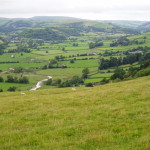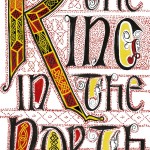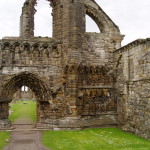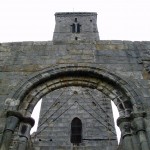2014 is turning out to be the year of the Norsemen! As well as visiting the Vikings: Life and Legend exhibition at the British Museum and attending the Midlands Viking Symposium in the spring, last weekend I took time out from working on my latest novel-in-progress to go to the Unlocking the Vikings conference at
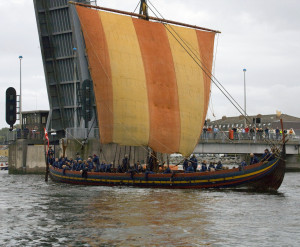
The reconstructed Viking ship, Sea Stallion, the subject of Tom Birkett’s paper at the Unlocking the Vikings conference, sails into Dublin, 14 August 2007.
(Image adapted under the Creative Commons Attribution-ShareAlike 2.0 Generic licence from an original photo by William Murphy.)
2014 is turning out to be the year of the Norsemen! As well as visiting the Vikings: Life and Legend exhibition at the British Museum and attending the Midlands Viking Symposium in the spring, last weekend I took time out from working on my latest novel-in-progress to go to the Unlocking the Vikings conference at the University of Nottingham.
In common with last year’s The Middle Ages in the Modern World at the University of St Andrews, the focus of the two-day event was as much upon the various ways in which the Viking Age has been represented in modern culture as it was upon the history itself. There were so many excellent papers and presentations – too many to mention individually – but I’ve chosen some of what, for me, were the highlights of the weekend.
The first session of the conference focussed on the Vikings in fiction, something of great interest to me since the Norsemen feature prominently both in Tancred’s saga and in the wider story of the Norman Conquest. Historian and novelist VM Whitworth (University of the Highlands and Islands) spoke about developing Viking Age characters, and the need for authors to fully immerse themselves in the thought-world of their creations. Ruarigh Dale (University of Nottingham) discussed portrayals of berserkers in current fiction, and how modern concepts compare with the original descriptions of these warriors in the Norse sagas.
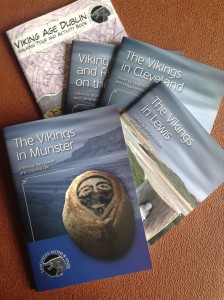
The findings of the Languages, Myths and Finds project were brought together in these five beautifully produced booklets.
The conference also marked the conclusion of the Languages, Myths and Finds project, which aimed to investigate how Norse heritage and culture continue to make an impact in the twenty-first century, and the ways in which the Viking past is remembered and celebrated in Dublin, Munster, the Isle of Man, the Hebrides and Cleveland. Each of the regional teams presented their findings, which included the dramatic reveal by the Cleveland researchers of a previously unknown Viking runestone – an especially exciting discovery since, in contrast to Scandinavia, so few have been found in England.
As well as giving presentations at the conference, the teams also produced a series of booklets containing the findings of their research (pictured, above left): one for each of the five regions explored in the study. The booklets can also be downloaded in PDF form from the Languages, Myths and Finds website, where you can also find out more about the project and its aims. The video below from the University of Nottingham also gives a brief introduction.
Other highlights from the conference included a skaldic performance by Thor Ewing, featuring music on reconstructed Viking Age harp and flute, and a paper by Tom Birkett (University College Cork) on his experiences aboard the Sea Stallion – a reconstructed Viking ship based on the remains of Skuldelev 2, an eleventh-century vessel excavated at Roskilde, Denmark in 1962.
As always with these events, I came away brimming with ideas and armed with several pages of notes, furiously scribbled during the various talks and presentations. And who knows? Somewhere in all those notes might lie the inspiration for a future novel or two…
On this week’s edition of In Our Time, the long-running BBC Radio 4 series, the topic under discussion was Domesday Book. One of the most significant documents in English history, it is unparalleled in form and scope, and one of the greatest legacies of the Norman Conquest.
On this week’s edition of In Our Time, the long-running BBC Radio 4 series, the topic under discussion was Domesday Book. One of the most significant documents in English history, it is unparalleled in form and scope, and one of the greatest legacies of the Norman Conquest.
Commissioned by William the Conqueror in 1085, it is, in essence, a kingdom-wide record of who held what estates and other assets in England and how much they were all worth. The level of detail sought by the men carrying out the inquest was remarkable, even if not all of it necessarily made it into the final, edited version. As one of our key sources for the period, the Anglo-Saxon Chronicle, comments in its entry describing the Domesday Survey:
“…there was not one single hide, not one yard of land, not even (it is shameful to tell – but it seemed no shame for him to do it) one ox, not one cow, not one pig was left out, that was not set down in his [King William’s] record.”
Joining Melvyn Bragg to discuss Domesday Book, the circumstances of its creation, the processes of the survey that supplied the information, its contents and its lasting impact, were three eminent scholars of the Norman Conquest: Elisabeth van Houts, David Bates and Stephen Baxter. It’s a fascinating debate; even after 900 years there remain several unanswered questions as to how it was put together and the exact reason for its being commissioned.
If you missed it, you can catch up online or else download the discussion as a podcast to listen to later from the BBC website. The In Our Time archive includes many excellent programmes related to Anglo-Saxon England and the Norman Conquest, and indeed history in general. In time I plan to compile a list of the best ones and post the links here on the website for anyone who’s interested in finding out more.
For the moment, however, here are two of my favourite programmes from the archives: firstly, Alfred and the Battle of Edington, about the West Saxon king’s struggles against the Viking invaders; and secondly, if you’re looking for further insight into life in England post-1066, The Norman Yoke, exploring and questioning the idea that the Conquest was necessarily a Bad Thing that resulted in many years of harsh oppression for the Anglo-Saxons.
If you’re interested in looking deeper into Domesday Book, meanwhile, or in exploring the history of your own home town or village, you need go no further than the Open Domesday project. Combining map data with records from the survey, it’s a visual, searchable database of who held what property in England, both on the eve of the Conquest in 1066 and at the time of the survey two decades later. It’s free to access, and easy to use.
And of course I can’t talk about Domesday Book and go without mentioning my own grand historical survey of the kingdom of England c.1066, Tancred’s England. With just three location entries so far, it’s not quite on the scale of that eleventh-century masterwork, which records 13,418 places and contains over 2 million words, but I’ll be adding to it bit by bit over the coming months. Any comments, including suggestions for other places that I could feature in Tancred’s England, are welcome – just let me know via the Contact page.
Today I’m launching a brand new section here on the website! Eagle-eyed visitors might already have noticed the new link on the menu bar above, nestled between Bio and Blog. Entitled Tancred’s England, the idea is to offer an insight into the history behind some of the key places featured in the
Today I’m launching a brand new section here on the website! Eagle-eyed visitors might already have noticed the new link on the menu bar above, nestled between Bio and Blog. Entitled Tancred’s England, the idea is to offer an insight into the history behind some of the key places featured in the Conquest Series, and to share some of the research that goes into the writing of the novels.
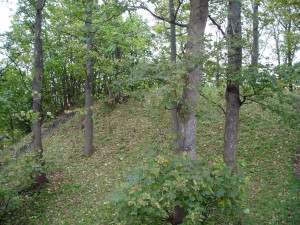
Baile Hill, on the western bank of the River Ouse, is all that survives of York’s second castle, constructed in spring 1069.
So far you’ll see that I’ve posted information about three locations, and there will be more to follow in due course. To begin with I’ve chosen to feature the two great Anglo-Saxon cities of York and London, as well as Ely and the Fens – where the English outlaw Hereward and his allies made their stand against King William in 1071.
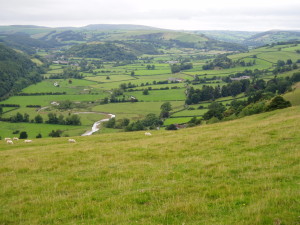
The valley of the River Teme to the north of Knighton, not far from Tancred’s fictional manor of Earnford. Taken from Offa’s Dyke Path, looking north-west.
I’ll be expanding the Tancred’s England section and adding fresh content to each of these pages in the coming months, with entries on Durham, Bristol and the Welsh March all in the works. So keep checking back from time to time to see what’s new, and if you have any suggestions for things that I could add or which you’d like to know more about, please get in touch with me via the Contact page.
A prince-in-exile makes his triumphant return from obscurity, slaying the tyrant who was ravaging his homeland and reclaiming the throne that, half a lifetime earlier, was stolen from him, before establishing himself as one of the pre-eminent kings of his age and ushering in a golden age for his people. The story of King Oswald
A prince-in-exile makes his triumphant return from obscurity, slaying the tyrant who was ravaging his homeland and reclaiming the throne that, half a lifetime earlier, was stolen from him, before establishing himself as one of the pre-eminent kings of his age and ushering in a golden age for his people. The story of King Oswald of Northumbria (reigned 634-42) is a remarkable one – indeed the stuff of legend – and yet nowadays his achievements have largely been forgotten by most except Anglo-Saxon specialists.
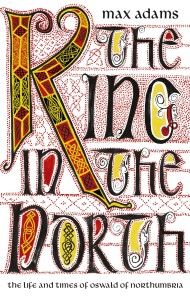
The King in the North
Max Adams • 448 pp. • Head of Zeus
Hardback • £25.00
In keeping with the book’s subtitle, “the life and times of Oswald of Northumbria”, Adams does not examine his subject’s career in isolation, but also explores the array of societies and cultures – religious and secular – that inhabited seventh-century Britain, and so places his reign in its historical context. While Oswald, his achievements and his afterlife as the focus of a saintly cult form the backbone of the book, a significant amount of attention is given also to the career of his predecessor Edwin (616-32) as well as to the long reign of his successor, his brother Oswiu (642-70). Indeed The King in the North is less a biography of a single man than it is a study of a dynasty, and of the leading role played by Northumbria in the politics, religion and culture of seventh-century Britain. This was a land divided: a land of seemingly perpetual conflict between rival families, Anglo-Saxons and Britons, new and old customs, pagans and Christians, and even between different branches of the Church: the Irish, the British and the Roman traditions.
Oswald’s reign as king was relatively short – only eight years – and yet his impact in that time was decisive in forging the Northumbrian kingdom. After ousting a Welsh army from his ancestral homelands in order to claim his crown, he proceeded first to unite the ancient provinces of Bernicia and Deira under one rule and, later, to win a great victory over a coalition of forces drawn from the southern Anglo-Saxon kingdoms, which in the following century led the historian Bede to assert that he had “brought under his dominion all the nations and provinces of Britain.”
Exactly how much can and should be read into these words isn’t clear. It would perhaps have been useful to have seen a deeper interrogation of Bede’s statement, which Adams accepts at more or less face value. There’s no doubt that both Oswald and Oswiu were among the most powerful rulers of their age, and widely respected throughout these isles. What’s more questionable is the extent to which they can be justifiably said to have been overlords over all the kingdoms of Britain, south as well as north of the Humber. What might this overlordship have entailed? How might it have been achieved and exercised in practice? What was the exact extent of their authority, and was it was uniform throughout the territories that lay beyond their kingdom’s borders? Given that their power base was centred upon Bamburgh, it is hard to imagine how they could have exercised much influence over Wessex or Kent, for example.
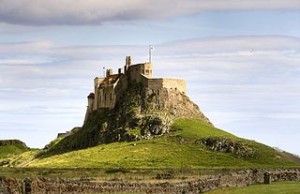
Lindisfarne Castle on Holy Island. The castle was built in 1550, re-using stone from the Norman priory. (Photo credit: Matthew Hunt. Reproduced under the Creative Commons Attribution 2.0 Generic licence.)
Around these events Adams expertly weaves his account. If the title of The King in the North is intended as a nod towards George R. R. Martin’s A Song of Ice and Fire series, then the comparison between the world of Oswald and that of Eddard Stark is an apt one. The political landscape of seventh-century Britain was a ruthless and volatile one, in which rival dynasties pursued vicious bloodfeuds and in which fortunes of entire kingdoms could be overtuned at a single sword’s blow. Elaborately constructed networks of alliances and tribute rarely outlived the rulers at their head. Power rested in the hands of the most military successful: those who were able to attract the largest warbands, and who were able to prove their throne-worthiness through victory in battle.
The great triumph of Adams’ study is in bringing all this to life. Impeccably researched, compellingly written and accessible to the general reader as well as to the specialist scholar, The King in the North vividly reconstructs the world that Oswald not only inhabited but also helped to shape.
Devoted readers of this blog will remember that last June I ventured north to the University of St Andrews for a four-day conference on The Middle Ages in the Modern World, exploring how our medieval past has been remembered, depicted, referenced, re-created and reconstructed in more
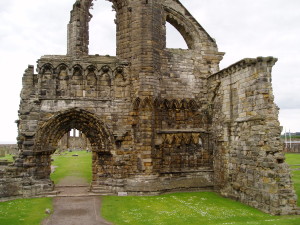
The ruins of St Andrews Cathedral. At 119 metres (391 feet) in length, it’s the largest church ever to have been built in Scotland.
As well as giving a paper of my own on representing the Middle Ages in fiction, I also had the chance to meet and share ideas with historians and people from a wide range of other academic disciplines whose work involves the medieval in one way or another.
I was also privileged to be able to attend the lecture that closed the conference, which was delivered by Nobel Prize-winning poet Seamus Heaney in what was probably one of his final public appearances before he died just a couple of months later.
Five of the keynote lectures, including Heaney’s, were recorded on video and have now been posted on the conference website for anyone interested in getting a taste of what the conference was all about. The five lectures are:
Saints’ cults and celebrity: the medieval legacy
James Robinson (National Museums Scotland)
Adapting medieval romance
Felicitas Hoppe (author and translator)
The worlding of medievalism: past and present in the early anthropocene
Bruce Holsinger (University of Virginia)
European ethnicity: does Europe have too much past?
Patrick Geary (Institute for Advanced Study, Princeton)
“Feinyit Fablis and Ane Cairfull Dyt”?: a Reading with Commentary
Seamus Heaney (Nobel Prize-winning poet)
The week following the conference, the British Academy in London held a special event with Patrick Geary and broadcaster, actor and writer Terry Jones, chaired by Dr Chris Jones from the University of St Andrews, in which they reprised their presentations and discussed the continuing relevance of the Middle Ages. The video of this event is also now online on the British Academy website.
All of the lectures are well worth watching if you have the chance. Between them they give a fairly good idea of the variety of subjects that were discussed over the four days, exploring how ideas and misconceptions of the Middle Ages have informed, and are reflected, in disciplines as wide-ranging as literature, politics and even climatology, which was the focus of Bruce Holsinger’s particularly excellent talk – just one of my many highlights of the conference.
In case you missed them the first time around, catch up with Part One and Part Two of my report from “The Middle Ages in the Modern World”.
Among the many great panel sessions at The Middle Ages in the Modern World at the University of St Andrews was one entitled “Dirt, Dirty Doings and Doing the Dirty”, presented by Susan Aronstein (University of Wyoming), Laurie Finke (Kenyon College), Amy Kaufman (Middle Tennessee State
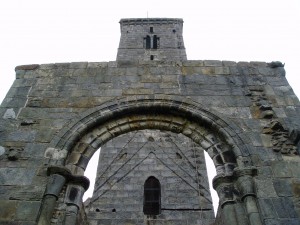
The 12th-century tower of St Rule (St Regulus), in the grounds of St Andrews Cathedral.
While many of these and other dramatisations dress themselves in the lavish costumes, scene-dressing and CGI that are the hallmarks of the so-called “sexy historical”, the content is often much less glamorous. The main focus of the discussion revolved around the prevalence and degrees of vice, debauchery and violence (including sexual violence) depicted in these programmes, their portrayal of women, and the ways in which they make use of the commonly held belief that the Middle Ages were a period in which life was “nasty, brutish and short”.
Clearly this is a very skewed and limited vision of the period, and yet it seems to be one that the US-based cable networks such as HBO, Showtime and Starz, who commission and in large part fund these series, have hit upon as a means of drawing in viewers. A similar formula can also be found in the treatments afforded to The Tudors and The Borgias. Why is it that this recipe has recently found success, and should we be concerned that the Middle Ages are getting such a bad press?
It should be noted that this new brand of “dirty medievalism” is, by and large, the preserve of the cable channels. Indeed in the UK, the BBC’s dramatic uses of the Middle Ages have tended to be oriented more towards family entertainment, with series such as Merlin and Robin Hood offering a very different depiction of medieval life: one that is gentler and interspersed with humour. Which of the two approaches, if either, presents a better reflection of the medieval reality?
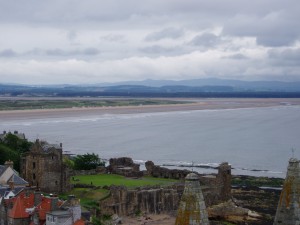
St Andrews Castle (foreground), with West Sands Beach and the North Sea beyond.
Nevertheless, I’d hope that readers of my novels come away with the sense that kinship, duty and love did matter to medieval people, just as they matter to Tancred and his allies, and that there was honour to be found in their world. While treachery, backstabbing, power games and violence abounded, it seems strange to argue that these facets were peculiar to the Middle Ages, or that they were the main distinguishing features of that period. For that reason, as entertaining as these recent TV dramatisations are, there remains for some a nagging sense that, in limiting their vision, they do the Middle Ages a disservice.
Needless to say it was a fascinating discussion – one of many over the course of the conference. Even now, more than a week after coming back, I’m still working my way through and absorbing the various notes I made. I hope to share some more of my findings from my time in St Andrews in the not too distant future!
If you missed it last week, catch up with Part One of my report from “The Middle Ages in the Modern World”.


